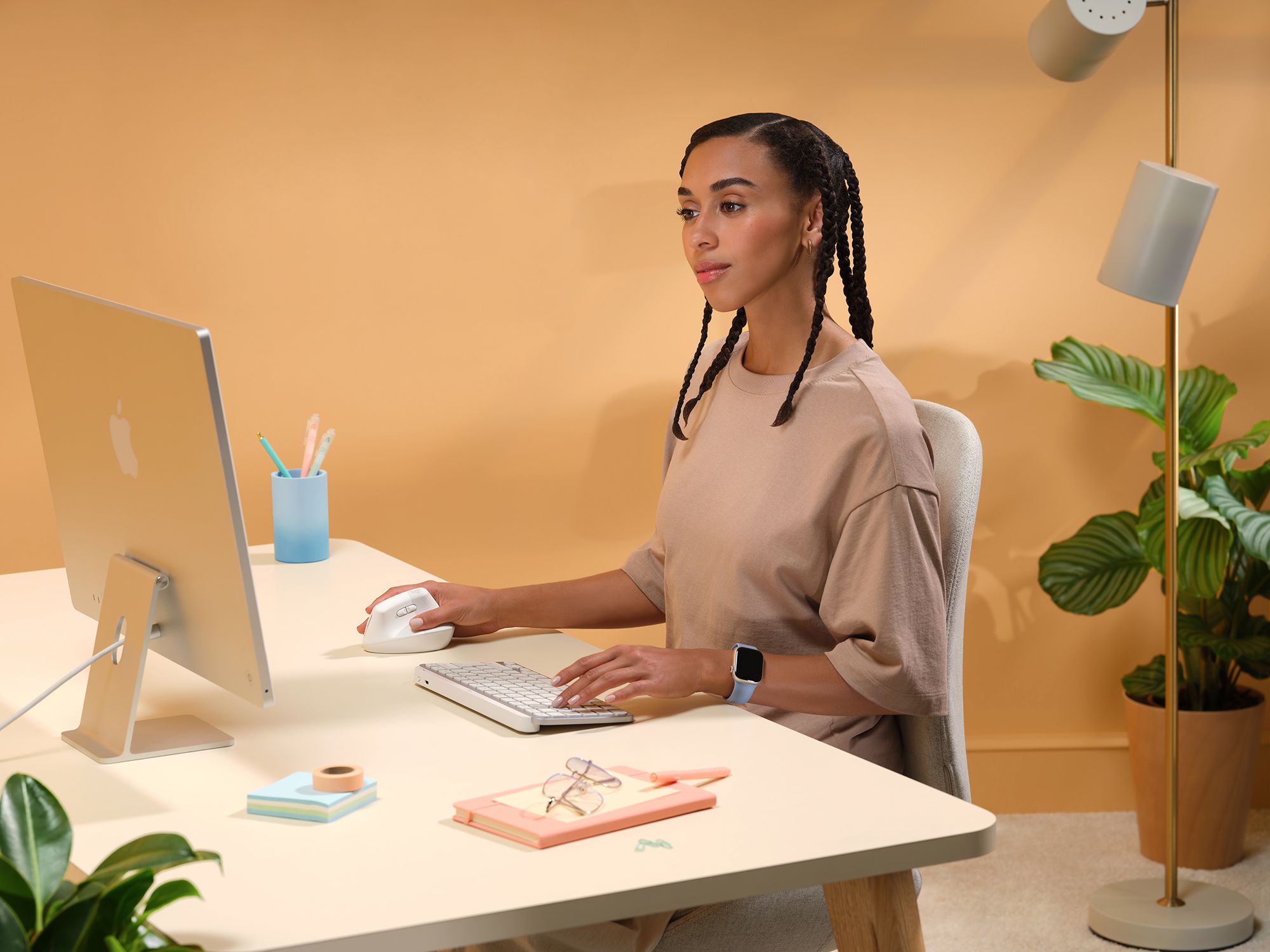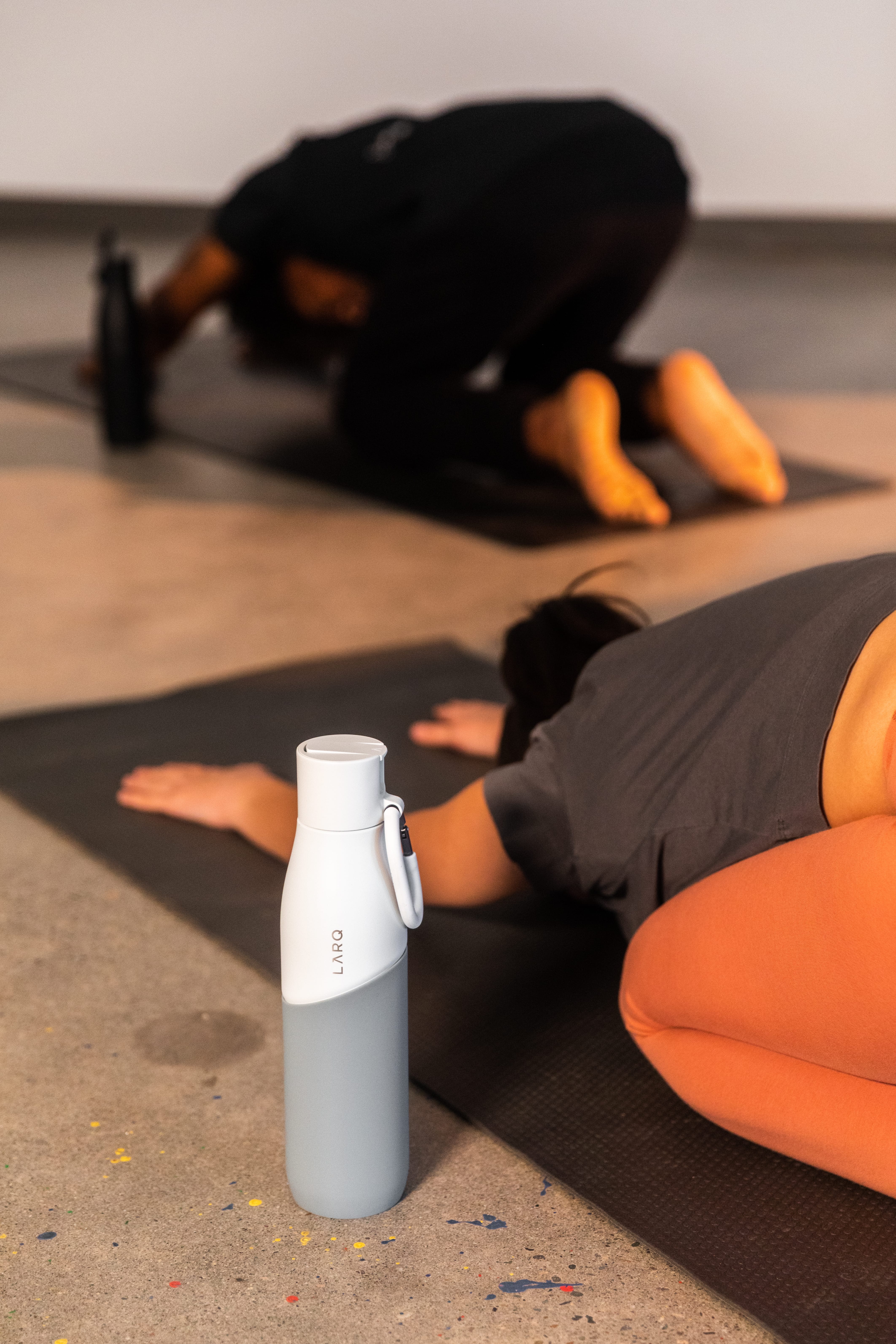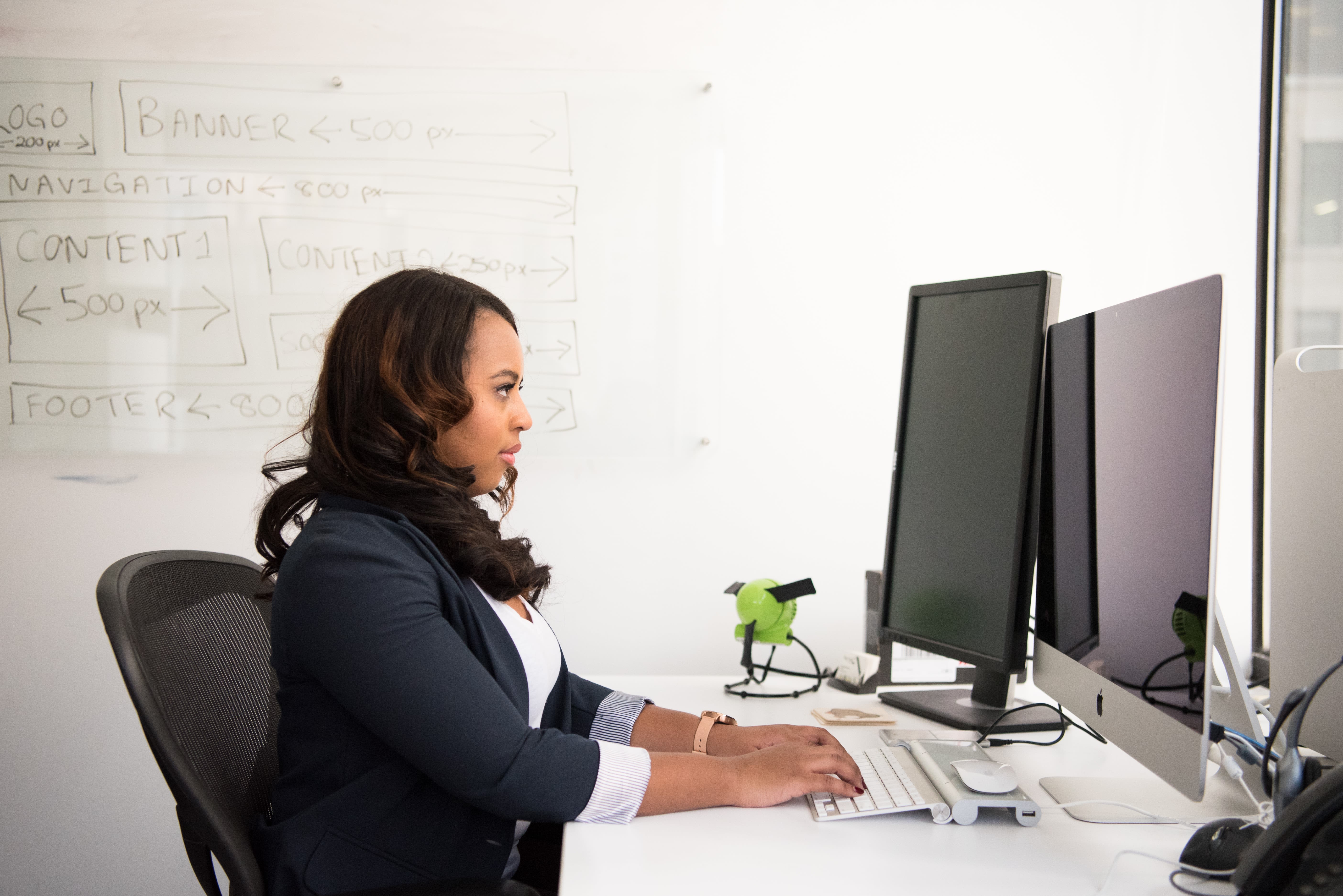Good posture is one thing, but if your desk set up isn’t optimized for it, you’ll find yourself feeling it in your neck, back, wrists, and more pretty quickly. Home or otherwise, bookmark this for your ergonomic desk makeover!
Stay hydrated!
Dehydration is an unexpected workplace hazard that is actually quite common. In fact, research shows that “ just 1% of body water loss, workers begin to experience decreased cognitive abilities”. Thus, a 3-4% dehydration rate can bring about a 25% decline in worker productivity.
You’ll have no problem remembering to drink plenty of water by keeping a reusable LARQ Bottle close-by. If it’s right in front of you, you might just remember to drink from it. And, if you don’t, the unique blue light ring that appears every 2 hours during a self-cleaning cycle will hopefully be enough of a nudge!

80% of people don’t drink enough water — that’s a staggering amount! We get it, it’s hard to remember sometimes, especially when you’re in the zone. However, your health is directly linked to hydration. Proper hydration can improve your metabolic efficiency, maintain adequate blood pressure, improve respiratory immunity, maintain healthy skin, and even help your body absorb necessary minerals and nutrients—to name a few. Research presented by the European Society of Cardiology also noted that adequate hydration throughout life also may reduce the risk of heart failure.
So, do yourself a massive favor, and get into the habit of drinking more water every day. The average woman should be drinking 11.5 cups (2.7 liters) of fluids a day, and men should be drinking 15.5 cups (3.7 liters) of water a day. This includes all liquids—including juices, smoothies, and even tea or coffee. There are a few factors to take into account that will require drinking even more water to prevent dehydration, which includes: exercise, living in a hot or humid environment, when you’re sick, or if you’re pregnant or breastfeeding. We’re huge proponents of having a reusable water bottle with you everywhere you go. And at home or at the office are no exception. Get a beautifully designed LARQ water bottle that can hold more water than an average sized glass would to encourage yourself to drink more. It’s a game-changer.
Plus, the beauty of the LARQ Bottle PureVis is that you don’t have to wash it every day — it’s self-cleaning! PureVis technology uses UV-C LED technology to eradicate bio-contaminants like E.coli and prevent your bottle from smelling (we’ve all been there). Even if you forgot your bottle in the office or in the car—no big! The battery lasts up to a month so you can pick right back up where you started sans funky smells.
Go ergo
There’s a reason so ergonomic gear has achieved so much buzz lately. Ergonomically designed keyboards and mice can help reduce pressure, strain, twisting and bending of your wrist and hand while adding support for a greater level of comfort—even after long hours. Sometimes our physical discomfort or pain can lead to emotional stress. Ergonomic gear can help alleviate that strain so you can focus on more important stuff.

A vertical mouse helps reduce pressure on your wrist and puts your hand in a more neutral position. Pay attention to size too — comfort comes from something that will fit your hand just right. Luckily there are a few sizes of ergonomic mice to steer you in the right direction.
When it comes to your keyboards, they’re not one size fit all. Those with smaller hands might prefer more compact keyboards to reduce strain on your fingers, and vice versa. Some might want a more ergonomic keyboard especially designed to relieve pressure on the wrists from extensive typing (we’re looking at you, writers!).
Stand and stretch
An adjustable desk makes it easy for you to alternate between sitting and standing to help alleviate any strain on your hip flexors from sitting for too long at a time. A standing desk could be helpful too, but sometimes that can cause pressure on your feet and knees at long periods at a time. We’d recommend an adjustable sit/stand desk instead.
Sometimes we get too sucked into our work and lose track of time, so downloading an app to remind yourself to change positions can be helpful. Try incorporating some “deskercises” into your work day to reduce discomfort and health issues caused by sitting too long.

Taking a few minutes to cat-cow every couple of hours could be hard to achieve in the office, but getting up to refill your water is a great excuse to stand and stretch, take a walk outside, or simply take a minute for yourself near a window before slowly making your way back to the desk.
Put it in neutral
Make sure your arms and legs are in neutral positions – bent 90° at the elbows and knees with legs planted on the ground. If your desk level is too high, this might cause excessive strain on your shoulders. If it’s too low, you might experience some strain on your wrist. The 90° rule is a neutral position where your arms can rest comfortably on your desk as you’re working.
Having your legs in this neutral position can encourage you to sit upright with your back straight. You’ll notice that kicking your feet out will make your back arch, which can cause back pain after long periods of sitting. It feels comfortable at the moment, but you shouldn’t sit like this for hours.
Monitor your screens
Experts advise that the position of your monitor matters greatly for your posture. Most say that the top of your head should be level with the top of your monitor. The monitor may also be tilted upwards slightly toward eye level to be at a better angle for viewing as you scan your screen. Your monitor should also be about an arm’s length away from you.

If you find yourself hunching over close to your monitor, this may be a sign that you’re not able to see clearly from your neutral position. If this is the case, try using your zoom function to see images or text more clearly from a healthier distance. You might also want to consider seeing your optometrist to check your vision if it is a deeper issue—it might be better than having to see a physical therapist from the bad posture!
Reduce digital eye strain
Digital eye strain can lead to fatigue, difficulty sleeping, and even headaches! The 20-20-20 rule encourages you to take breaks from staring at your screen every so often. To try this method out, take a 20 second break every 20 minutes and look at something 20 feet away. Can you do it? Get into the habit by setting a timer to remind yourself to look away from your screens — your phone counts too!
Find the perfect seat
Working full-time at a desk means that the chair you’re doing all this sitting in becomes more important. There are a wide variety of ergonomic chairs to choose from, but investing in a good quality, well-designed chair for spending hours working in could be well worth your while.
I’m sure you’ve heard the name Herman Miller before when it comes to office ergonomics, and it’s for good reason. Herman Miller is considered one of the best makers of ergonomics office chairs in the biz. Their office chairs are designed to provide balanced support and movement in a sturdy yet dynamic frame.
When choosing a chair, there are a few things to consider—height of the back of the chair, depth of the seat, and height adjustability of the armrests, and seat height.
The height of the backing provides support for your back of course, and you’ll want something that offers lumbar support as well. If you lean back a lot in your chair, you might want something that goes higher—maybe even has a headrest. When it comes to lumbar support, everyone’s back is different, so adjustability or going to test one out in a store might help you make the best decision for you.
To encourage good posture, the perfect depth is one that allows your back to rest on the chair back while allowing your knees to bend at the 90° angle we discussed earlier. A seat depth that is too long may cause your back to round, and too shallow of a depth will cause your legs to work harder to support you. Some chairs are adjustable on this front, but you’ll have to check those limitations.
Armrests make a huge difference when it comes to office ergonomics. As we mentioned earlier, your arms should rest at 90° when you’re typing or using your mouse. This helps reduce strain on your neck, shoulders and even wrists. Your armrests should be level with your desk so that your arms can rest in this neutral 90° position. It’s a heck of a lot more comfortable this way, believe us.
Last but not least, you’ve got to have a chair with the right height. If your legs are dangling or if it feels like you’re squatting in it — you’re gonna need to find a better chair. As we mentioned before, your legs should be bent at 90° and with your feet flat on the floor.
